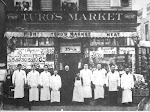During the 1400 hundreds, it was in the possession of the Genevois and the Princes of Savoy and later under Sicilian, Sardinian, Spanish, Austrian and finally French rule. You can clearly see the influence of these countries in the cuisine. The production of salami can be found in shops and farm stands throughout the region. Some stuffed with hazelnuts or rolled in crushed peppercorns and herbs. Large ones, small links, soft and hard varieties are produced by small farms in the area.
The old village (Annecy-le-Vieux) rambles along the Canal du Thieu where passages along the streets are lined with colorful houses and flowers. It is a strange beauty in a way, as many of the houses look as if they will crumble into the canal at any time. Paint clings onto the buildings, but losing its battle. This tableau of colorful buildings precariously leaning in all directions is simply charming. The arcades are lined with shops with traditional crafts, antiques, dried flowers, and chocolates. The small restaurants that are tucked into these houses serve foie gras de carnard, fondue Savoyarde, salade du chèvre chaud or poisson du lac. You think, should I chance walking up the narrow stairs; the scent of the Savoie specialties lures you up to small restaurants with views of the canal and cafés below.
There is a farmers market on Saturdays with vendor stands throughout the old city. Along the street crowded with people waiting to make their purchases, you can find local specialties such as kraut and saucisson cooked in large copper pots, fromage melted on large crusty pieces of bread, freshly made local breads, pastries as well as fresh fish, fruits and vegetables. There are many antique shops and once a month there is an antique market along the arcades (check the web page for exact dates).
Locals fill the large park located at the lakeside on the weekends. Children enjoying the carousel and beg to go on again and again. There are ball games and people just taking in the sun or enjoy the day with friends and family outdoors. Artists painting the unique village create memories for tourists of Anncey for many years to come.
Brasseries line the narrow passages along the canal and the specialty of plateau fruits de mer is our favorite. My husband and I actually enjoy going to Anncey on a grey day and even light rain. Sitting in a brasserie with a large plateau du fruits de mer and a bottle of local white wine is one of our favorite ways to spend a rainy day.
Anncey is a romantic resort town. If you are visiting France or the French region of Switzerland, take a side trip to Anncey. It is about 1 hour from Geneva and 5 1/2 hours from Paris.
Check the Anncey tourist web site for more history, cultural events and markets (www.annecy.org).
The recipe below is from France Monthly (www.francemonthly.com). Tartiflette is a typical "Savoie" dish.
La Tartiflette
Servings: 6
Preparation time: 50 minutes
Ingredients
2 1/2 lbs of potatoes
1 medium onion (larger or smaller according to your taste)
1/2 lb Canadian bacon
1 Reblochon cheese (or 1 lb of Swiss Gruyere)
3/4 cup white
2 Tablespoons oil
Salt and Pepper
Directions:
The recipe recommends that you use a cheese from the region, called "Reblochon", and a white "Savoie" wine. This latter is very difficult to find in the United States and we therefore advise you to use a bottle of white Burgundy (Chablis, Saint Veran, Macon Village) or of Muscadet (from the Loire region).
The recipe recommends that you use a cheese from the region, called "Reblochon", and a white "Savoie" wine. This latter is very difficult to find in the United States and we therefore advise you to use a bottle of white Burgundy (Chablis, Saint Veran, Macon Village) or of Muscadet (from the Loire region).
If you cannot find the Reblochon, or prefer a milder cheese, Swiss Gruyere can be used. To accompany this dish we recommend a green leaf salad.
Peel potatoes and boil or steam for 20 minutes.
Peel onion and cut into thin slices.
Heat large frying pan with the oil and sauté the onion slices.
Cut bacon into small cubes and add to pan.
Cook on medium heat until onion slices are soft (10 minutes).
Stir as needed. Add potatoes that have been diced and pour white wine over it. Salt and pepper to taste. Cook over medium heat for 10 minutes, stirring occasionally.
Cut the Reblochon in two halves across its thickness. If you are using Gruyere, slice in thin strips. Put half of the potato preparation in a round ovenproof dish. Place half of the Reblochon (or Gruyere) cheese side down, on top. Cover with remaining potatoes and finish with the second half of the Reblochon (or Gruyere).
Place in 350º F oven for 20 minute.

















